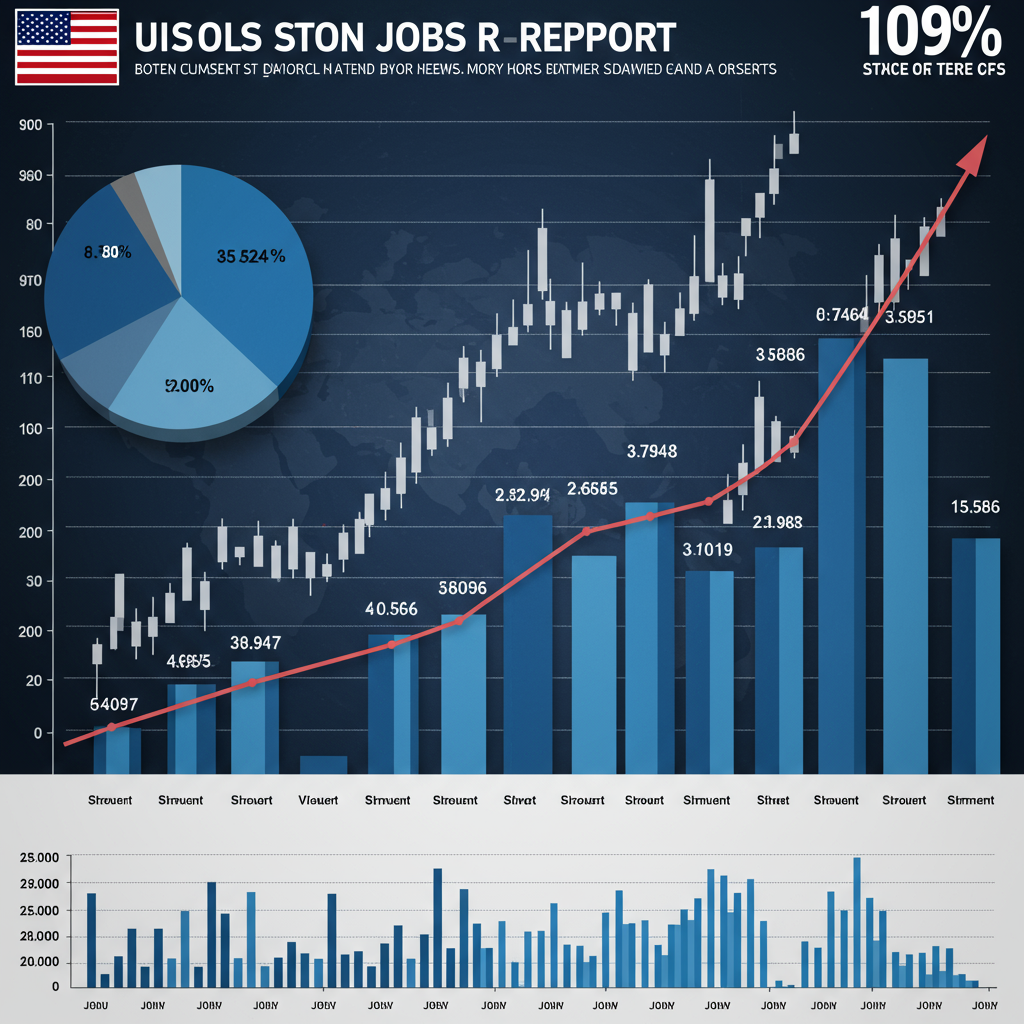At first glance, the June US jobs report delivered impressive headline numbers, suggesting a robust and thriving economy. With a historically low unemployment rate, significant job creation, and wage growth that appeared to keep pace with inflation, the top-line figures painted a picture of strength. Many observers initially celebrated these statistics as clear evidence of economic resilience. However, much like peering beneath the hood of a seemingly perfect vehicle, a closer examination of the underlying data points revealed a more complex, and in some areas, concerning reality. This deeper dive exposed blemishes that challenged the initial rosy outlook, suggesting potential weaknesses lurking beneath the surface of the positive June jobs report.
The positive headline numbers were certainly compelling. The reported gain of 147,000 net jobs soundly surpassed the consensus expectation of 117,500, demonstrating continued hiring momentum. Gains were notable in typically stable sectors such as local and state government, education, healthcare, and leisure and hospitality. These figures initially bolstered confidence in broad economic expansion.
Adding to the positive narrative, the unemployment rate unexpectedly fell to 4.1%. This decline defied forecasts that predicted a rise to 4.3%, pushing the rate back down from levels seen earlier in the year. Furthermore, the monthly revisions offered a positive signal; April and May job figures were both revised upward, a welcome change from prior reports that often saw downward adjustments to previous months’ data.
Concerns Lurk Beneath the Surface
Despite the encouraging headline statistics, a detailed analysis of the June jobs report revealed several critical indicators that pointed toward underlying softness or potential future challenges. These less-discussed figures provided a more nuanced, and in some cases, worrying perspective on the state of the US labor market. Ignoring these details means missing crucial signals about economic health.
Difficulty Finding Work Persists
One significant concern highlighted in the report was the increasing difficulty many Americans faced in securing employment. The average duration of unemployment rose notably, climbing from 21.8 weeks to 23 weeks. Simultaneously, the proportion of unemployed workers who had been out of a job for 27 weeks or longer edged up to 23.3%. This moved the figure closer to a three-year high, indicating that long-term joblessness remained a persistent issue for a segment of the workforce, despite the low overall unemployment rate.
Sectoral Weaknesses Appear
The report also showed concerning weakness in specific sectors. Manufacturing employment, often seen as a key indicator of industrial health, experienced a decline for the second consecutive month, shedding 7,000 jobs. This particular trend was viewed as a setback for economic priorities focused on boosting domestic manufacturing. Beyond manufacturing, the analysis revealed that job growth was not as widespread across the economy as the headline number might suggest. The largest monthly gains were concentrated in sectors less affected by external factors like trade policies.
Average Workweek Declines
Another subtle but potentially telling detail was the slight decrease in the average workweek, which edged down by one-tenth of an hour to 34.2 hours in June. According to economists, a dip in the average number of hours worked can sometimes signal a weakening in the overall demand for labor from employers. While a small change, it contributed to the picture of a labor market perhaps not as uniformly robust as the top-line numbers suggested.
Uneven Impact on Demographic Groups
The June jobs report data also indicated that the positive trends were not evenly distributed across all demographic groups. The unemployment rate for Black Americans, for instance, rose from 6% to 6.8%. While this number can be volatile month-to-month, the increase marked its highest rate since January 2022, often considered an indicator of economic softness impacting certain communities more severely. Furthermore, the report provided data suggesting a notable gender disparity in recent labor force participation trends. Analysis indicated that since the beginning of the year, a net total of 338,000 women had left the labor force, while 183,000 men had joined.
Nuances in Wage Growth
While the report mentioned wage growth outpacing inflation, a closer look revealed complexities. Although average hourly earnings saw an increase in June, the pace of this growth slowed compared to earlier expectations. Monthly growth was just 0.2%, bringing the annual growth rate down to 3.7% from 3.9%. This deceleration in the rate of wage increases added another layer of nuance to the otherwise positive interpretation of wage trends, suggesting the pace might be moderating.
The Labor Force Participation Puzzle
Perhaps one of the most complex aspects of the report involved understanding the dynamics of the labor force itself. The official unemployment rate calculation depends not only on the number of unemployed people but also on the total size of the labor force (those working or actively looking for work). The June data showed that while the unemployment rate decreased, the overall size of the labor force also declined. This paradox is partly explained by a significant loss of foreign-born workers, estimated at over 1 million in the preceding quarter. A shrinking labor force can mechanically lower the unemployment rate even if the number of people out of work does not decrease proportionally, or even increases. This “fuzzy math” presented a less optimistic view of labor market depth.
Policy Context and Broader Implications
The original analysis of the June jobs report linked some of the emerging concerns, particularly in manufacturing and labor force dynamics, to specific economic policies enacted or debated at the time. Trade tariffs and fluctuations in their implementation were cited as causes of uncertainty, potentially leading businesses to delay hiring or investment decisions. Additionally, large-scale immigration crackdowns and targeted deportations were seen as impacting the availability of foreign-born workers, a crucial segment of the labor force in recent years.
This theme of political and policy-driven uncertainty influencing economic indicators continued to be relevant in subsequent months. As later data emerged (like the July and August jobs reports), political debates escalated, with different political campaigns attributing both positive and negative economic news to opposing policies. For instance, the July 2024 jobs report showed a significant slowdown in hiring and an unexpected rise in the unemployment rate to 4.3%, sparking immediate political blame trading.
Similarly, the August report, while showing job gains rebounded slightly from July, still indicated a pace of hiring significantly slower than earlier in the year and saw downward revisions to prior months’ figures (contrasting with the June report’s upward revisions). These subsequent reports continued to present mixed signals to economists and policymakers.
The Fed’s Challenge and Ongoing Uncertainty
The complex and sometimes contradictory nature of the US jobs report data, evident in June and continuing through subsequent months like July and August, poses a significant challenge for institutions like the Federal Reserve. Tasked with managing monetary policy, including setting interest rates, the Fed relies heavily on economic indicators like the jobs report.
Mixed signals make it difficult for the data-dependent Fed to determine the appropriate course of action. For example, a dip in the unemployment rate might suggest caution is needed before cutting interest rates too aggressively, fearing a potential resurgence of inflation. Conversely, signs of slowing hiring, declining workweeks, or rising long-term unemployment could argue for more aggressive rate cuts to support a weakening economy. The ambiguity found in the June jobs report, amplified by the conflicting signals in later data, underscored the difficulty policymakers face when the available economic evidence points in multiple directions. This uncertainty surrounding both the labor market’s true health and future policy responses leaves businesses and workers navigating a state of flux.
Frequently Asked Questions
How could the June jobs report show a low unemployment rate but also signal concerns?
The June jobs report showed a low unemployment rate (4.1%) because this rate is a calculation based on the total labor force. While the number of people reporting they were unemployed was low relative to the labor force size, the report also showed the total labor force had shrunk significantly (over 1 million fewer foreign-born workers). This means the rate could fall even if finding a job became harder for those seeking one, as indicated by rising average unemployment duration and an increasing share of long-term unemployed workers mentioned in the report.
Which specific areas or groups showed worrying trends in the June jobs data?
The June jobs report highlighted several specific areas of concern. Manufacturing employment declined for the second straight month, losing 7,000 jobs. Overall job growth wasn’t widespread, concentrating in certain sectors. The unemployment rate for Black Americans increased significantly (from 6% to 6.8%). Data also suggested more women were leaving the labor force compared to men entering it, indicating uneven impacts across demographic groups.
Did the negative trends seen in the June jobs report continue in later months like July or August?
Yes, some negative trends highlighted in the June jobs report did persist or reappear in subsequent months, according to external reports. For example, later July and August reports also showed weaknesses in certain sectors like manufacturing and retail. While the August report saw job gains rebound from July, the overall pace of hiring was still slower than earlier in the year, and revisions to previous months’ data turned downward again in July and August, contrasting with June’s upward revisions. This suggested the mixed picture and underlying softness noted in June were part of a continuing trend.
Conclusion
The June jobs report, while presenting seemingly positive headline figures like robust job gains and a low unemployment rate, contained crucial details that warranted a more cautious interpretation. Beneath the surface, rising long-term unemployment, declines in key sectors like manufacturing, a shorter workweek, uneven impacts on demographic groups, nuanced wage growth, and a shrinking labor force pointed to underlying complexities and potential fragilities in the US economy. These concerns, linked in part to policy-related uncertainties, created a mixed picture that continued to challenge economists and policymakers in subsequent months, making decisions like interest rate adjustments particularly difficult. Ultimately, understanding the nuances of the June jobs report requires looking beyond the headlines to grasp the full scope of the labor market’s condition and its implications for the broader economy.



